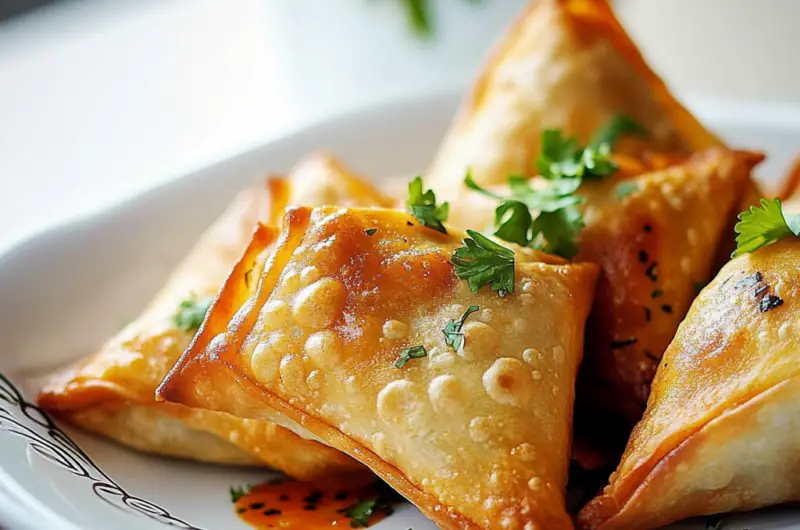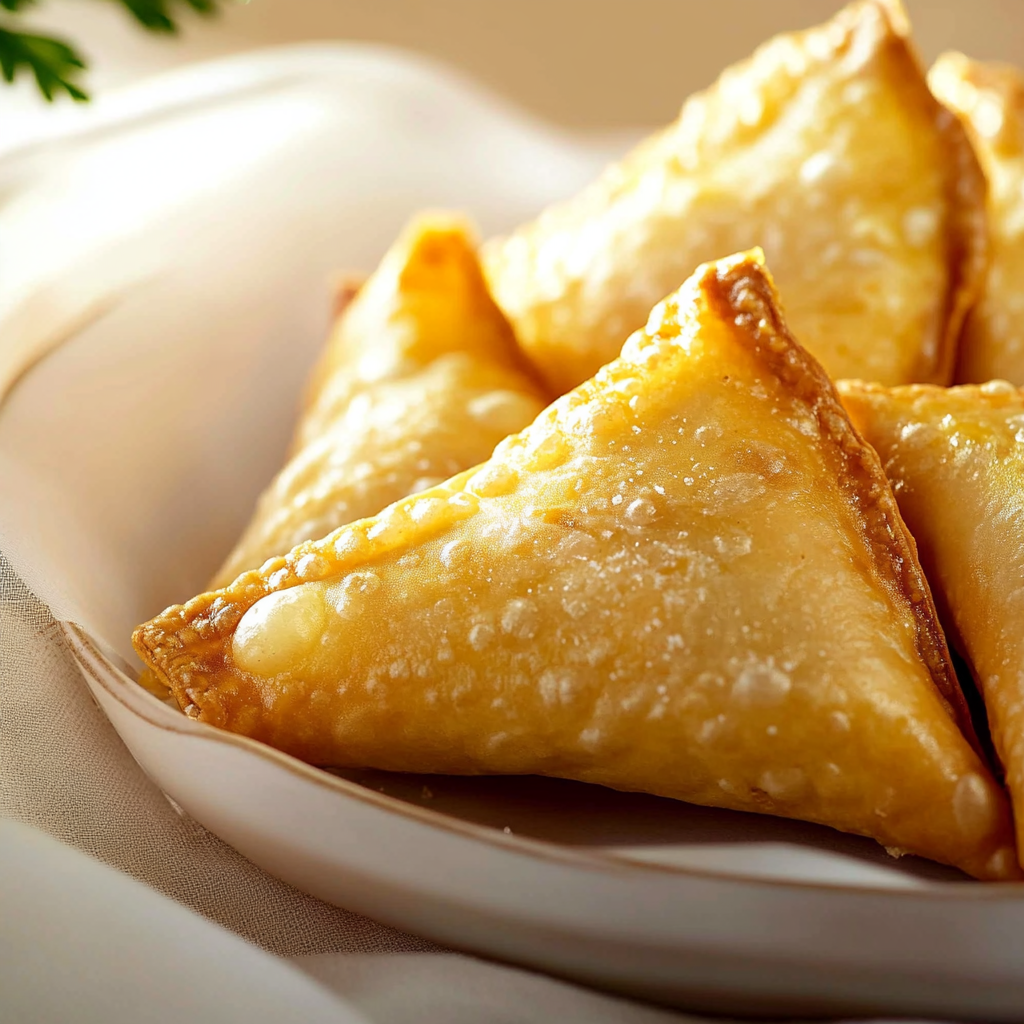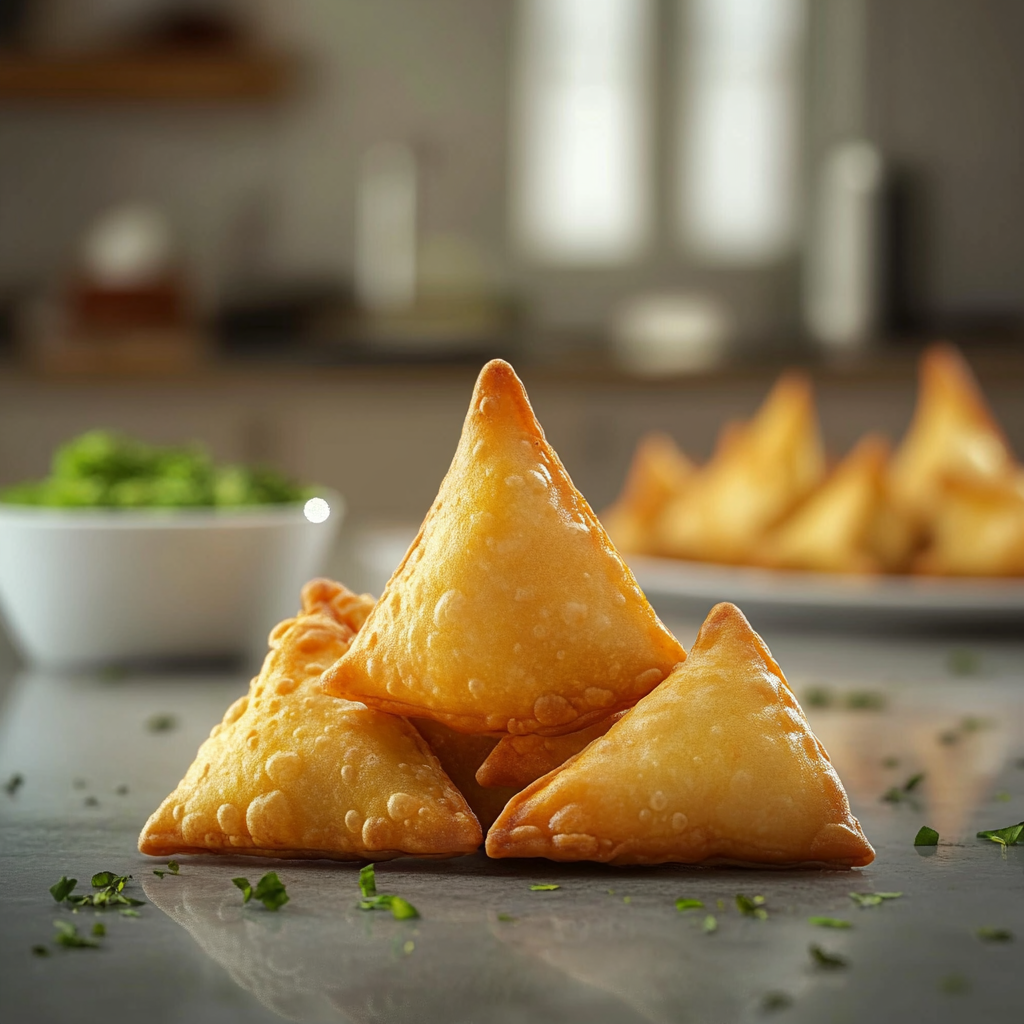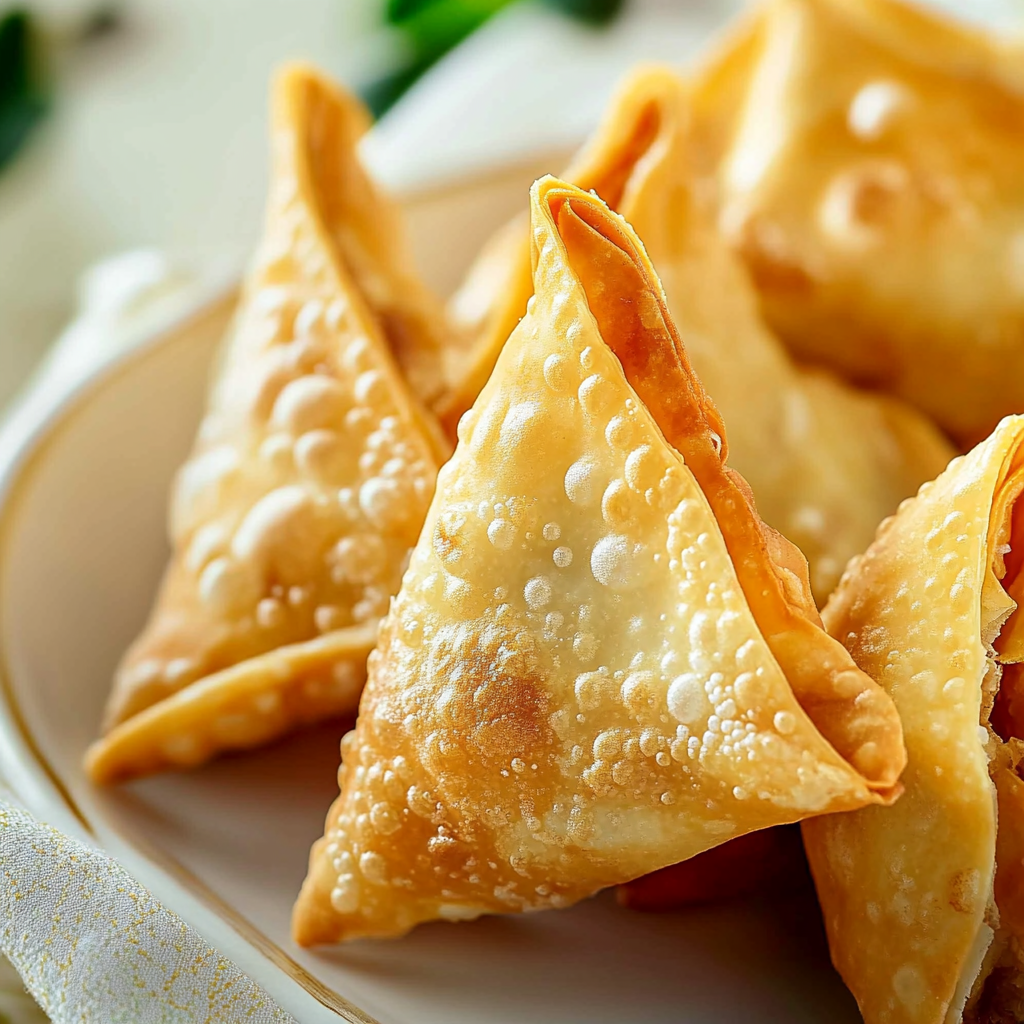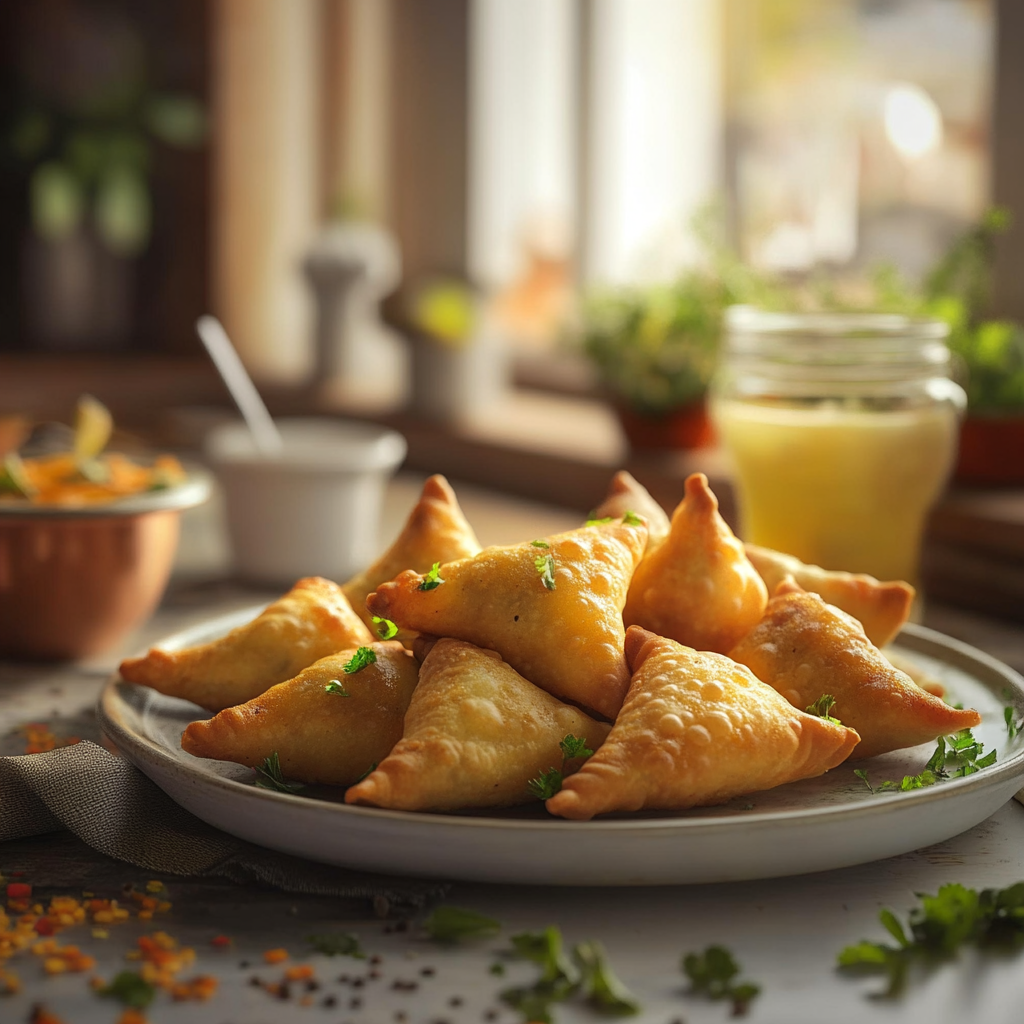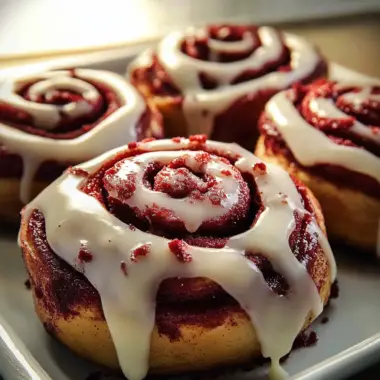Samosas are a beloved snack that captures the essence of comfort food with their crispy exterior and flavorful filling. Originating from the Indian subcontinent, these delightful pastries have gained popularity around the world. Whether served as an appetizer at parties or enjoyed as a street food delight, samosas offer a satisfying crunch paired with savory goodness. This recipe will guide you through creating perfectly golden-brown samosas filled with spiced potatoes and peas. In just a short time, you can impress your family and friends with this easy-to-follow recipe that is sure to become a staple in your home. With endless variations available, you can customize your fillings to suit your taste preferences. With these simple steps, you’ll be enjoying hot, homemade samosas fresh out of the fryer or oven.
Why You’ll Love This Samosas
-
- Quick and Easy: With minimal prep time and straightforward steps, even novice cooks can create this delightful dish without stress
-
- Flavorful and Versatile: The combination of ingredients delivers outstanding flavor. You can easily customize it by adding your favorite ingredients or adjusting the spices to suit your palate
-
- Perfect for Any Occasion: Whether it’s a family gathering, game day, or simply a cozy evening at home, samosas are always a hit among guests
- Great for Meal Prep: Make a batch ahead of time and freeze them for quick snacks whenever you need something delicious
Ingredients for Samosas
Here’s what you’ll need to make this delicious dish:
-
- All-purpose flour: This serves as the base for the dough; opt for high-quality flour for better texture.
-
- Potatoes: Use medium-sized potatoes; they should be starchy to create a fluffy filling.
-
- Green peas: Fresh or frozen peas add sweetness and color to the filling.
-
- Cumin seeds: These provide an earthy flavor; toast them lightly before adding them to enhance their aroma.
-
- Coriander powder: This spice adds depth to the filling; ensure it’s fresh for maximum flavor.
-
- Garam masala: A fragrant blend of spices that elevates the overall taste profile.
- Oil for frying: Choose vegetable oil or ghee; ensure it’s hot enough before frying the samosas for crispiness.
The full ingredients list, including measurements, is provided in the recipe card directly below.
How to Make Samosas
Follow these simple steps to prepare this delicious dish:
Step 1: Prepare the Dough
In a large mixing bowl, combine all-purpose flour with salt and enough water to form a soft dough. Knead well until smooth and let it rest covered with a damp cloth.
Step 2: Cook the Filling
Boil the potatoes until tender. Peel and mash them in a bowl before adding green peas, cumin seeds (toasted), coriander powder, garam masala, salt, and pepper.
Step 3: Roll Out Dough
Divide the rested dough into small balls. Roll each ball into thin circles on a floured surface.
Step 4: Shape the Samosas
Cut each circle in half to form semicircles. Fold one semicircle into a cone shape by joining two straight edges together, sealing with water along the edge.
Step 5: Fill and Seal
Fill each cone with about one tablespoon of potato-pea mixture. Seal the top edge securely using water.
Step 6: Fry Until Golden
Heat oil in a deep pan over medium heat. Fry the samosas in batches until golden brown on all sides. Drain on paper towels before serving.
Transfer to plates and serve hot with chutney or sauce for an added burst of flavor!
Tips and Tricks
Here are some helpful tips to ensure the best results for your dish:
-
- Even Cooking: Make sure all ingredients are cut to similar sizes for consistent cooking times.
-
- Temperature Control: Let ingredients reach room temperature before starting for better results.
-
- Advanced Technique: For enhanced flavor, try marinating your filling overnight; it makes all difference
- Crispiness Factor: Ensure oil is hot enough before frying; if it’s too cool, samosas may turn soggy.
How to Serve samosas
This samosas is versatile and pairs wonderfully with:
Mint Chutney: This refreshing dip enhances the flavor profile of the samosas, adding a zesty kick.
Yogurt Sauce: Creamy yogurt balances the spices in the samosas, making every bite delightful.
Pickled Vegetables: The tanginess of pickles contrasts beautifully with the rich filling, offering a delicious crunch.
Fresh Cilantro Garnish: A sprinkle of cilantro adds brightness and freshness, elevating the presentation.
Feel free to pair it with your favorite sides for a personalized meal!
Make Ahead and Storage
- Make Ahead: Prepare the samosa filling a day in advance and store it in an airtight container in the refrigerator. You can also assemble the samosas ahead of time; just keep them covered with a damp cloth to prevent drying out.
- Storing: Refrigerate any leftover samosas in an airtight container for up to 3 days. For longer storage, wrap them tightly in plastic wrap and freeze for up to 3 months.
- Reheating: To reheat, bake frozen samosas at 375°F (190°C) for about 25-30 minutes until heated through and crispy. For refrigerated ones, heat in a preheated oven at 350°F (175°C) for about 10-15 minutes.
Suggestions for samosas
Use Fresh Ingredients
When making samosas, the quality of ingredients plays a crucial role in the final taste. Avoid using stale or low-quality flour and spices. Fresh vegetables and herbs enhance flavor significantly. When selecting potatoes for your filling, choose firm ones without blemishes, as they provide the best texture when cooked. Freshly ground spices bring out the authentic flavors of your samosas, while pre-ground spices can lose potency over time. Always ensure that your oil is fresh and heated to the right temperature for frying. Using expired or reused oil can impart an unpleasant taste to your samosas and affect their crispiness.
Perfect Your Dough Consistency
The dough is fundamental to making delightful samosas; hence, achieving the right consistency is vital. If the dough is too dry, it will crack while rolling out, leading to undesirable results. Conversely, overly sticky dough can be challenging to work with and may not hold its shape during frying. Aim for a smooth and pliable texture by mixing flour with a pinch of salt and enough water until you achieve a soft but firm consistency. Allowing the dough to rest for at least 30 minutes can help develop gluten, resulting in a more elastic texture that’s easier to roll and shape.
Master Folding Techniques
Folding samosas perfectly ensures they are sealed well during cooking, preventing any filling from leaking out. A common mistake is rushing through this step, leading to poorly sealed edges. Start by rolling out your dough into thin circles, then cut them in half. Form a cone shape with one half by overlapping the edges and sealing them with water or a bit of flour paste. Fill it carefully with your mixture before sealing the top edge completely. Practicing this technique will not only improve their appearance but also ensure that each samosa remains intact while cooking.
Fry at the Correct Temperature
Frying samosas at the right temperature is crucial for achieving that perfect golden-brown color and crispiness. If the oil is too hot, the exterior may burn while leaving the inside undercooked. On the other hand, if it’s too cool, the samosas will absorb excess oil, becoming greasy instead of crispy. Ideally, maintain an oil temperature of around 350°F (175°C). You can test this by dropping a small piece of dough into the oil; it should sizzle and rise to the surface immediately if it’s hot enough. Maintain steady heat throughout frying for even cooking.
FAQs
What are traditional fillings for samosas?
Traditional samosa fillings often include spiced potatoes mixed with peas or lentils. The spices typically used are cumin seeds, coriander powder, garam masala, turmeric powder, and chili powder for heat. Additionally, some recipes incorporate meat such as chicken or lamb seasoned with similar spices for non-vegetarian versions. Experimenting with different vegetables like carrots or bell peppers also creates unique flavors while keeping within authentic guidelines.
Can I bake samosas instead of frying?
Yes! Baking samosas is a healthier alternative to frying without sacrificing flavor or texture when prepared correctly. To bake them successfully, brush each assembled samosa lightly with oil to promote browning and crispness during baking. Preheat your oven to around 400°F (200°C) and bake them on a lined baking sheet until golden brown—typically about 20-25 minutes—flipping halfway through for even cooking.
How do I store leftover samosas?
To store leftover samosas properly, allow them to cool completely before placing them in an airtight container. They can be refrigerated for up to three days or frozen for longer preservation—up to two months is ideal when sealed well in freezer-safe bags or containers. Reheating frozen samosas can be done directly from frozen either in an oven or air fryer until heated through and crispy again.
What dips pair well with samosas?
Samosas are delicious on their own but pairing them with dips enhances their flavor profile significantly. Popular options include mint chutney made from fresh mint leaves blended with yogurt or coriander chutney featuring cilantro and green chilies for heat. Tamarind sauce adds sweetness and tanginess that really complements spicy fillings as well. For those who enjoy creaminess, yogurt-based raita provides a cooling effect against spicy flavors.
Conclusion for samosas
In conclusion, making perfect samosas requires attention to detail throughout each step of preparation—from selecting fresh ingredients to mastering folding techniques and ensuring proper frying temperatures. Avoid common mistakes like using stale ingredients or not allowing dough to rest adequately; these simple adjustments can elevate your dish significantly. Additionally, consider experimenting with various fillings and accompaniments like chutneys that enhance flavors further while providing delightful variety to your table. By following these suggestions closely, you will create mouthwatering samosas that impress anyone fortunate enough to indulge in them!
Delicious Samosas Recipe
Course: All Recipes4
servings30
minutes20
minutes150
kcalSavor the delightful crunch of homemade samosas, a beloved Indian snack that perfectly marries crispy pastry with a spiced potato and pea filling. These savory pastries are not only quick and easy to make but also versatile enough to suit any occasion, whether it’s a family gathering or a cozy night in. Discover how to create these delicious treats in just a few simple steps, and impress your guests with their irresistible taste and texture.
Ingredients
All-purpose flour
Potatoes
Green peas
Cumin seeds
Coriander powder
Garam masala
Oil for frying
Directions
- Prepare the dough by mixing all-purpose flour with water and a pinch of salt until soft. Let it rest.
- Boil potatoes until tender; mash them and mix in green peas, cumin seeds, coriander powder, garam masala, salt, and pepper.
- Roll the rested dough into thin circles and cut them in half.
- Form cones from the semicircles, fill with the potato mixture, seal the tops securely.
- Heat oil in a pan and fry the samosas until golden brown on all sides. Drain on paper towels.
Notes
- Customize fillings by adding spices or vegetables like carrots or paneer for variation.
For a healthier option, bake samosas by brushing them lightly with oil before placing them in a preheated oven at 400°F (200°C) for approximately 20-25 minutes.

